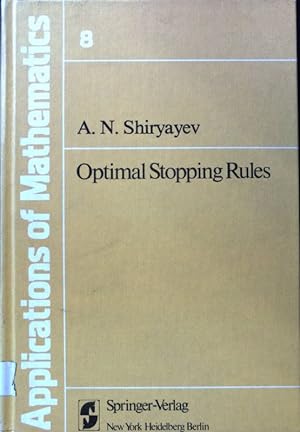optimal stopping rules (5 Ergebnisse)
Suchfilter
Produktart
- Alle Product Types
- Bücher (5)
- Magazine & Zeitschriften (Keine weiteren Ergebnisse entsprechen dieser Verfeinerung)
- Comics (Keine weiteren Ergebnisse entsprechen dieser Verfeinerung)
- Noten (Keine weiteren Ergebnisse entsprechen dieser Verfeinerung)
- Kunst, Grafik & Poster (Keine weiteren Ergebnisse entsprechen dieser Verfeinerung)
- Fotografien (Keine weiteren Ergebnisse entsprechen dieser Verfeinerung)
- Karten (Keine weiteren Ergebnisse entsprechen dieser Verfeinerung)
- Manuskripte & Papierantiquitäten (Keine weiteren Ergebnisse entsprechen dieser Verfeinerung)
Zustand Mehr dazu
- Neu (2)
- Wie Neu, Sehr Gut oder Gut Bis Sehr Gut (1)
- Gut oder Befriedigend (2)
- Ausreichend oder Schlecht (Keine weiteren Ergebnisse entsprechen dieser Verfeinerung)
- Wie beschrieben (Keine weiteren Ergebnisse entsprechen dieser Verfeinerung)
Einband
Weitere Eigenschaften
- Erstausgabe (1)
- Signiert (Keine weiteren Ergebnisse entsprechen dieser Verfeinerung)
- Schutzumschlag (Keine weiteren Ergebnisse entsprechen dieser Verfeinerung)
- Angebotsfoto (3)
Sprache (1)
Preis
- Beliebiger Preis
- Weniger als EUR 20 (Keine weiteren Ergebnisse entsprechen dieser Verfeinerung)
- EUR 20 bis EUR 45
- Mehr als EUR 45
Gratisversand
Land des Verkäufers
Verkäuferbewertung
-
Optimal Stopping Rules (Stochastic Modelling and Applied Probability, Vol. 8)
Verlag: Springer (edition First Edition), 2007
ISBN 10: 3540740104 ISBN 13: 9783540740100
Sprache: Englisch
Anbieter: BooksRun, Philadelphia, PA, USA
Erstausgabe
Paperback. Zustand: Very Good. First Edition. It's a well-cared-for item that has seen limited use. The item may show minor signs of wear. All the text is legible, with all pages included. It may have slight markings and/or highlighting.
-
Optimal stopping rules. Applications of mathematics ; 8;
Verlag: New York, Heidelberg, Berlin : Springer, 1978
ISBN 10: 0387902562 ISBN 13: 9780387902562
Sprache: Englisch
Anbieter: books4less (Versandantiquariat Petra Gros GmbH & Co. KG), Welling, Deutschland
gebundene Ausgabe. Zustand: Gut. 217 Seiten; Der Erhaltungszustand des hier angebotenen Werks ist trotz seiner Bibliotheksnutzung sauber. Es befindet sich neben dem Rückenschild lediglich ein Bibliotheksstempel im Buch; ordnungsgemäß entwidmet. Einbandkanten sind leicht bestoßen. In ENGLISCHER Sprache. Sprache: Englisch Gewicht in Gramm: 620.
-
Optimal Stopping Rules (Stochastic Modelling and Applied Probability, 8).
Anbieter: Antiquariat Bernhardt, Kassel, Deutschland
gebundene Ausgabe. Zustand: Sehr gut. Stochastic Modelling and Applied Probability, Band 8. Zust: Gutes Exemplar. 227 S. Englisch 608g.
-
Optimal Stopping Rules
Verlag: Springer Berlin Heidelberg, 2007
ISBN 10: 3540740104 ISBN 13: 9783540740100
Sprache: Englisch
Anbieter: moluna, Greven, Deutschland
EUR 108,72
EUR 48,99 für den Versand von Deutschland nach USAAnzahl: Mehr als 20 verfügbar
In den WarenkorbKartoniert / Broschiert. Zustand: New. Although three decades have passed since first publication of this book reprinted now as a result of popular demand, the content remains up-to-date and interesting for many researchers as is shown by the many references to it in current publications.
-
Optimal Stopping Rules
Verlag: Springer, Berlin, Springer Berlin Heidelberg, Springer, 2007
ISBN 10: 3540740104 ISBN 13: 9783540740100
Sprache: Englisch
Anbieter: AHA-BUCH GmbH, Einbeck, Deutschland
Taschenbuch. Zustand: Neu. Neuware - Along with conventional problems of statistics and probability, the - vestigation of problems occurring in what is now referred to as stochastic theory of optimal control also started in the 1940s and 1950s. One of the most advanced aspects of this theory is the theory of optimal stopping rules, the development of which was considerably stimulated by A. Wald, whose Sequential ~nal~sis' was published in 1947. In contrast to the classical methods of mathematical statistics, according to which the number of observations is fixed in advance, the methods of sequential analysis are characterized by the fact that the time at which the observations are terminated (stopping time) is random and is defined by the observer based on the data observed. A. Wald showed the advantage of sequential methods in the problem of testing (from independent obser- tions) two simple hypotheses. He proved that such methods yield on the average a smaller number of observations than any other method using fixed sample size (and the same probabilities of wrong decisions). Furth- more, Wald described a specific sequential procedure based on his sequ- tial probability ratio criterion which proved to be optimal in the class of all sequential methods. By the sequential method, as applied to the problem of testing two simple hypotheses, we mean a rule according to which the time at which the observations are terminated is prescribed as well as the terminal decision as to which of the two hypotheses is true.






